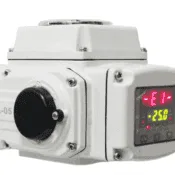



COVNA Electric Temperature Control Valve
This electric single-seat (sleeve type) control valve is compact in design and excellent in performance. It is a high-quality basic electric control valve. It is specially developed for production process control systems of general fluid media. It has the advantages of stable operation, small oil leakage, ideal flow characteristics, wide adjustment range and smooth flow channel, which can fully meet the control needs of users in various application scenarios.
- Model: Electric control valve
- Size Range: 1” to 12”
- Pressure Range: 1.6 to 6.4MPa
- Material: Stainless Steel, WCB
Technical Parameters
| Nominal Pressure | ZZWPE-16CPN16 |
| Medium Temperature | ≤ 250 ℃, 350℃(Customized) |
| Power supply | 220VAC ±10 % 50Hz |
| Control signal | 4-20mA |
| Flow Characteristics | Equal percentage |
| Applicable media | Water, Steam, Oil |
COVNA Electric Temperature Control Valve Overview:
The 3810L series electronic actuators are powered by a 220V AC single-phase supply and receive control signals from a regulator. These innovative actuators are specifically engineered to execute precise, predetermined linear reciprocating movements.






